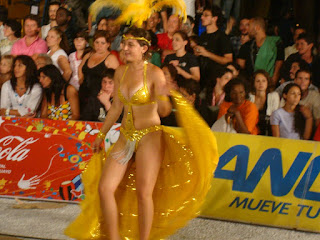It is in total contrast to the all-night, all-displayed, all-out and unlimited, uninhibited and undressed exuberance and excesses of the Rio carnival.
No surprise if you know Uruguay. The Uruguayans are serious and sober people. The country was in fact created as a buffer between the beach-loving Brazil and adventurist Argentina in the early ninteenth century. Uruguay is moderation and modesty between the the two large neighbours who are given to extremes.
Look at the parade of these kids...
 Yes .. The picture explains it. The carnival is for the family. Simple and sober. Nothing to shock the innocent.
Yes .. The picture explains it. The carnival is for the family. Simple and sober. Nothing to shock the innocent.But there is one similiarity with the Brazilian carnival, as is obvious from the picture below .
 There are a few people of African origin who lend their grace and skills at the Uryuguayan carnival. Foreigners tend to have the impression that Uruguay,like Argentina and Chile, does not have people of African origin.
There are a few people of African origin who lend their grace and skills at the Uryuguayan carnival. Foreigners tend to have the impression that Uruguay,like Argentina and Chile, does not have people of African origin. There was no African presence in the Gualeguachu Carnival ( my blog on that http://latinamericanaffairs.blogspot.com/2009/01/gualeguaychu-carnival.html#links) It was a blonde and bland show without the people of colour.
But in uruguay there are a few thousand Africans who stayed behind, while transiting through the Montevideo port during the days of slave trade. One does not see them in business or government circles, since they are a tiny minority. But they are in the forefront of the carnival. It is their show. It is they who add colour to the festival. It is their spirit, rhythm and drums which make the carnival vibrant. Most of the parade groups have African names such as Yambo, Sarabanda, Candongafricana, Candombe Aduana, Candombo Zambo, , Kindu, Curumbe, La Mazumba...
Of course, no one would go to the carnival just to see the drums and dress alone. Chicas are the central attraction in uruguay too. Do you see what i mean...

The Brazilian carnival is intense exihibition and enjoyment for one week. But in uruguay it is an extended leisurely get together and celebration spread over a whole month in february. Not continuously but twice a week. The parades are called as Llamadas- meaning calls. This name comes from the old tradition of the families calling each other to join the celebrations with singing and drum playing.
The main parades are held in one of the streets where makeshift sitting arrangements are made on both sides. Since it is a regular residential street, lot of people watch from their balconies and windows. Ticket prices for the benches are nominal costing between 5 and 10 dollars. Besides the parades there are Murgha events in which humour and satire sessions are held in theatres and streets.

Very accurate indeed :-)
ReplyDeleteUruguayan are truly modest...